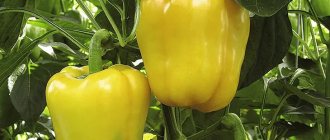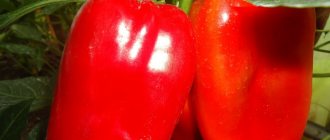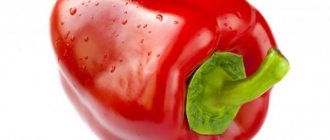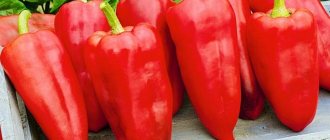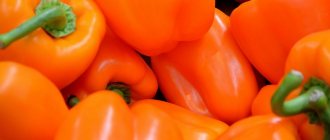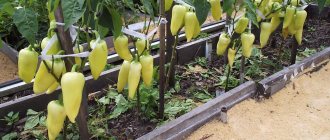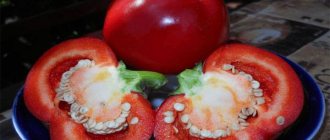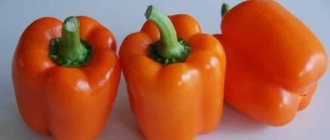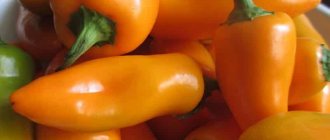California miracle pepper is suitable for experienced summer residents and beginners. This is one of the most popular types of pepper on Earth. There is a feeling that the California miracle bell pepper combines the advantages of the main varieties, without the presence of any disadvantages.
In this article we will talk in detail about the variety and help beginners and experienced summer residents understand it completely.
Bell pepper has become one of the most popular crops in the garden plots of summer residents in our country. Now it’s hard to believe that previously only greenhouse structures were used to grow these vegetables.
Planting in open ground was suitable only for the southern regions of the Russian Federation. But thanks to the fact that over time more and more new varieties of the crop appeared, and summer residents were looking for a suitable growing method, pepper spread widely throughout our country.
However, a beginner in this business needs to take due care and attention when choosing a plant for his site. There is a great desire to immediately reap a rich harvest of this amazing crop.
Description and characteristics of the variety
The “California Miracle” pepper variety, despite its exotic name, has perfectly adapted to domestic garden plots. It is almost impossible to visually note any serious differences from hybrid varieties of bell peppers. Large bright red fruits. Branched shrubs with strong stems.
Sweet pepper California miracle
The fruits of the “California miracle” may have a different shade of peel when ripe
Yellow pepper California miracle
Pepper Californian miracle orange
Pepper California miracle ripe green, on one bush with yellow
Pepper California miracle purple
California miracle chocolate pepper
Let's take a closer look at the characteristic features of this variety of sweet pepper:
- The shrub is of medium size, its height can reach 80 cm.
- The fruit, as a rule, acquires a cuboid shape during the ripening process. The surface is ribbed, visually divided into several lobules.
- The skin is dense, shiny, smooth.
- The pulp of “California” pepper is characterized by meatiness, juiciness and a memorable sweetish taste. The walls are 9 mm thick.
- At the stage of biological maturity, pepper acquires a bright scarlet hue, and technical maturity is characterized by a greenish tint to the peel.
One of the main distinguishing characteristics of the California Miracle variety is the high level of sugar in the pepper. “California Miracle” peppers are also known for the fact that they are equally excellent for eating fresh and for preparing stuffed dishes; we should also not forget about winter preparations. Thanks to their crispy and dense crust, the peppers retain their shape even when cooked.
Harvesting
California miracle has an average ripening period. The harvest is obtained 115–130 days after planting . Peppers are collected at the stage of technical maturity - when they are still green, but have already reached the desired size - and placed in boxes for ripening. The fruits acquire their characteristic color after 2–4 weeks. To avoid damaging the stem of the plant, it is recommended to cut ripe peppers with a knife.
Varieties of pepper California miracle
This variety of sweet pepper has another interesting feature. The fact is that the fruits of the “California miracle” may have a different shade of peel when ripe. The color of the fruit shell does not change the taste or other characteristics of the pepper at all, it only adds greater visual decorativeness to the shrub.
The following peel shades are possible:
- dark green (mistaken for technical immaturity of the fruit);
- rich yellow tint;
- red (the fruits visually become similar to persimmons);
- the most famous is a deep red shade;
- black with a purple gloss (extremely reminiscent of eggplant skin);
- deep chocolate shade that was released a couple of years ago.
Yellow and red peppers have the largest weight.
Advantages and disadvantages
The popularity of the California Miracle variety of sweet peppers among gardeners is quite easy to explain - there are a huge number of advantages over other similar varieties:
- excellent presentation of the fruit;
- taste qualities - juiciness, meatiness, lack of bitterness;
- the ability of the shrub to produce a good harvest not only in the greenhouse, but also in the open garden bed;
- the plant is quite unpretentious in maintenance;
- no need for pinching and creating supports for fixing the stems;
- fairly fast ripening period;
- versatility of using fruits (fresh, preserved, pickled);
- Peppers have a long shelf life, which makes them easier to transport over long distances.
Vegetable crops, regardless of their variety, tend to have a number of disadvantages that must be taken into account. Fortunately, the California Miracle has a minimal amount of them.
The only significant drawback of this variety is the low resistance of the plant to infectious and viral diseases. However, this problem is quite easy to overcome - you only need to periodically carry out the necessary preventive measures.
Features of cultivation
There are several features that should never be ignored when growing California Miracle seedlings:
- Do not overwater the soil. Despite the fact that this crop needs moist soil, excess water causes blackleg disease.
- The water used for watering seedlings must be heated, preferably pre-infused.
- Create conditions so that there are no drafts or excessively dry air in the room.
- If possible, try to extend the daylight hours for the plant. Buy special lamps for seedlings.
Seed preparation
An important step before planting seeds is their preparation. The process is quite simple, but extremely effective. Therefore, it is not recommended to ignore it:
- Soak the seeds in warm water and leave until they swell.
- After increasing their size, wrap them in a damp piece of cotton cloth and leave for 3 days.
Such manipulations with seeds allow for faster and more efficient germination. It has been noted that seeds planted directly into the ground germinate much longer and less readily. The seedlings eventually mature less vigorous and require additional feeding.
Planting seeds for seedlings
It is advisable to plant the seeds of sweet peppers, a special type of this variety, in separate containers or glasses. This is due to the fact that the root system of seedlings, subject to all conditions for growing this crop, develops very actively.
Fill the containers with a mixture of fertile soil, sand and humus, in a ratio of 1:1:2, respectively. The most preferable period for planting California Miracle seedlings is the month of February. Correctly carried out planting affects the future development of the plant, its resistance to infectious and viral diseases, as well as the quality of the fruit.
Place the seeds in the soil, making small depressions in the ground and sprinkle soil on top. Using a spray bottle, moisten the soil and cover the container with cling film to create a “greenhouse effect.”
Read about feeding pepper seedlings in our other article.
Picking seedlings
The roots of sweet peppers cope much worse with picking seedlings, compared to tomatoes or other vegetable crops. As a rule, they take longer to recover. Therefore, if possible, it is better to refuse diving. If a transplant is necessary for objective reasons, it is recommended to pay attention to the following nuances:
- Only seedlings that have already developed more than 3 leaves can be picked.
- Add a small amount of mineral fertilizer to the replanted soil. This will have a beneficial effect on the injured plant.
- The day before the dive, stop watering. A compacted lump of earth near the root system of the seedling will press on the stem with its mass and tear off the roots.
Transplanting seedlings into open ground
It is advisable to plant sweet pepper seedlings immediately after reaching the age of 65 days. Older seedlings are at high risk of injury during planting. A few days before planting, conduct a hardening course for the plant. To do this, periodically take the seedlings outside or leave the window open.
Before planting in the ground, make small depressions in the ground. Pre-loosen the soil and water the holes generously. Plant seedlings at a distance of 45 cm from each other, no less.
Use mulch to retain the soil moisture that bell peppers need. This, in turn, will help keep the soil loose and breathable.
Avoid placing hot pepper varieties together with “California” (sweet) peppers in the beds. The fact is that both varieties can cross-pollinate, which will contribute to a change in the taste of both plants.
A rich harvest is guaranteed provided that highly fertile soil was used during cultivation. Carefully pre-dug and moistened. Don't forget about the rules of crop rotation. When planning to grow sweet peppers of this variety in open beds, the most preferable site is the former place for growing onions, carrots and various representatives of legumes.
How to grow seedlings yourself at home?
The variety is grown using traditional technology by sowing seeds for seedlings. You can use both purchased and independently collected seeds. The fruit from which the seed material is collected is selected when fully ripe and picked from the best bush.
Did you know? Sweet peppers rank second in vitamin C content, ahead of citrus fruits, black currants and other plant sources of this vitamin.
Time for sowing
Seedlings are planted in open ground at the age of three months. In this regard, the seeds are planted at the end of February. Earlier sowing is possible subject to additional artificial lighting of the plants, which will ensure the required duration of daylight hours.
The soil
To grow seedlings, you can purchase soil at a store or garden center. If you have access to turf soil, you can prepare the soil mixture yourself.
The following proportions are suitable:
- 2 parts of turf land;
- 1 part each of fine sand and peat.
In order for seedlings to grow healthy, the soil mixture must be free from pathogens and pest larvae.
Find out what to do if the pepper does not grow or grows poorly.
Turf soil is disinfected by watering it with a solution of potassium permanganate, or in one of the following ways:
- steaming for 7–8 minutes;
- calcination in the oven for 30 minutes (at +70...+90° C);
- freezing and thawing of the soil (at –15° C, repeat up to three times).
Capacity
The assortment of stores includes plastic and peat containers for seedlings. For sowing without picking, individual cups are suitable, and if you plan to transplant plants, use a common shallow container for the first stage. It is necessary to prepare a cover or film to provide similar greenhouse conditions after sowing.
Seed preparation
Pepper seeds have good germination, but to ensure the best result, it is recommended to carry out a number of additional treatments.
Important! Seeds aged 1 have the best germination
–
2 years, then it’s better to collect new material.
Having manually selected the largest seeds, they are subjected to the following procedures:
- placed in a saline solution (3 g of salt per 1 liter of water) and “drowned” specimens are selected;
- pickled with a weak solution of potassium permanganate for 15–20 minutes;
- treatment with growth stimulants (according to instructions).
If the seeds are planted sprouted, they must be placed on a damp cloth or gauze, wrapped in film and left in a warm place until roots appear (1-3 days). Weak specimens are rejected.
Sowing seeds
The seeds are planted to a depth of 1 cm, sprinkled with soil and watered with warm water from a spray bottle. Since pepper does not respond well to transplantation, the seeds are planted in individual containers or leaving large gaps between future shoots. In this case, it will not be difficult to “pass” the sprouts with the earthen lump. The container with the inoculation is covered with glass or film and put in a warm place (+26…+28° C).
Seedling care
When the seedlings have appeared, the shelter is removed and the plants are moved to a bright place, illuminating the planting with lamps if necessary. The temperature must be maintained at +20...+25° C. Watering the seedlings is carried out as the top layer of soil dries, using settled warm water. If the plants are planted in a common container, transplantation is carried out after the appearance of two true leaves. Having a weak root system, pepper seedlings slow down after transplantation and take a long time to recover.
Important! Pepper seedlings need 12 hours of daylight!
Therefore, the container must be watered the day before so that the soil has optimal density and does not damage the roots. The plant is carefully removed with a lump of earth and replanted without deepening the growing point. Unlike tomatoes, you cannot cut off the central root when replanting peppers!
If the soil mixture is properly prepared and the plants look healthy, no fertilizer is required. In other cases, the first fertilizer is produced with nitrogen-potassium mixtures 7 days after the first transplant. The second feeding with an increased content of phosphorus and minerals is applied 4 days before the planned planting in open ground.
Hardening of seedlings
Ten days before transplanting, the seedlings begin to be hardened off: taken out into the open air, gradually increasing the “walk” time. In the last days, peppers should spend full daylight hours outdoors. The air temperature should not fall below +13° C. For hardening, choose a place that is not blown by drafts and is not burned by direct sunlight.
California Miracle Pepper Care
Keeping peppers in greenhouse conditions or in an open garden bed is not a very labor-intensive process, but it does require attention. Correct actions taken to care for shrubs with sweet peppers will definitely be rewarded with a bountiful harvest after 3 months.
Watering and fertilizing
“California Miracle” loves wet soil. But don't overdo it. Excess water will adversely affect the bush. Water as needed as soon as you notice that the soil has dried out. Periodically loosen the soil along the entire diameter of the bush. This will allow air to penetrate to the root system, and moisture will not stagnate.
You should also be careful with fertilizing. As a rule, for good plant growth and development, fertilizers based on phosphorus, nitrogen and potassium are used. For 1 sq. m requires no more than 45 g of feeding. A little less nitrogen is added – 25 g per 1 sq. m.
Relying on the experience of people who have been gardening for a long time, for the “California Miracle” variety, it is enough to apply fertilizing once in the spring. In the first weeks after planting seedlings in open ground.
Bush formation
In most cases, pruning sweet pepper bushes is done only by experienced gardeners. Beginners are convinced that even without the formation of the California Miracle bushes, the harvest will be rich. But an experienced gardener knows that the volume of the harvest and the size of the fruit can be increased by properly pruning the plant.
This variety is a tall plant, since the height of the bush can reach 80 cm. The bushes must be thinned out - plucked, and excess shoots that do not bear fruit must be removed. Such manipulations contribute to better passage of air and sunlight.
Pruning of sweet pepper varieties is done in order to regulate the above-ground part of the bush. Lack of timely pruning delays the ripening of fruits and contributes to a deterioration in their quality and taste. The formation of pepper bushes consists of removing:
- side shoot on the main stem;
- flower bud;
- small sections of main stems, especially those that produce a large number of shoots without fruit.
It is customary to leave the flower bud on the main stem so that it has time to sprout. After which the side shoot is removed along with the flower bud. However, one sheet must be left. So for each shoot there are two leaves, thanks to which it can feed.
Find out how to form peppers in your garden in the video below:
Harvesting
Fruit harvesting time directly depends on the following parameters:
- Accounting for the ripening time of varieties. In the case of the “California Miracle”, this is about 120 days from the moment of planting in open ground.
- Taking into account the characteristics of a particular type of pepper. This variety is sweet, which means the fruit ripens a little earlier compared to bitter varieties of peppers.
- Climate this season.
For those shrubs that were not kept in greenhouse conditions, the last parameter will be decisive. A heat-loving crop like peppers does not tolerate sub-zero temperatures. Therefore, when the first frost occurs, all the fruits available on the bushes are collected.
Having reached technical maturity, peppers can ripen on their own if they are placed in a warm room. By and large, many gardeners do not wait until sweet peppers reach biological maturity, but prefer to harvest in advance.
If the shrubs are grown in a greenhouse, then you can wait to harvest the crop when frost occurs. However, do not forget that at a stable cold temperature, the growth of vegetable crops stops and the plant stops its development. This means there is no point in delaying the harvest of fruits.
Another important factor is the shelf life and storage life of the California Miracle sweet pepper. The fruits of this variety have a long shelf life and are able to withstand transportation over long distances. However, this is only possible if the fruits were collected before biological maturity. Otherwise, it is recommended to consume the vegetable immediately fresh or preserve it or pickle it.
Fruit collection
This variety has a peculiarity: the fruits form and ripen in waves. Therefore, this must be taken into account when collecting. The first fruits are harvested when they turn green. There is no point in waiting until the peppers turn red or yellow in the first wave; a delay leads to a decrease in yield.
Peppers picked at technical ripeness ripen well at home. At this time, the plants take a short break, and then form new fruits with renewed vigor. The second batch of fruits can be left on the bushes until they are completely ripe.
On a note! When collecting your own seed material, you only need large fruits that have ripened on the branches.
At home, green peppers ripen in about 20-25 days. It is advisable to use ripe fruits for food and immediately put them into processing.
Diseases and pests
Dull and drooping leaves, often accompanied by dry edging, are a sign that the plant is in dire need of nitrogen fertilizer. If you notice purple spots on the back of the leaf, urgently fertilize the shrub with fertilizer based on magnesium.
There are not many diseases to which the “California Miracle” sweet pepper variety is susceptible:
- blackleg;
- late blight;
- macrosporiosis.
Treatment of the culture is carried out using chemical solutions called “Barrier” and “Barrier”. Treatment with drugs is carried out no later than 2 weeks before the start of harvest.
Like any other crop, sweet peppers are also susceptible to “attack” from insect pests. Typically this is:
- aphid;
- mole crickets;
- Colorado potato beetles.
The most effective means of controlling these pests is wood ash. It pollinates shrubs and the top layer of soil near the root system.
Reviews from gardeners
★★★★★
Sergey, 63 years old, summer resident, village. Suslonger. In recent years I have been growing only this variety of peppers.
Pleases with a rich harvest and large fruits. The taste is excellent and virtually no maintenance is required. ★★★★★
Yulia, 37 years old, dentist, Yekaterinburg. Very good variety!
Ideal for canning and stuffing, the peppers do not fall apart when cooked. People at home love the sweet taste and crispy crust. ★★★★★
Marina, 42 years old, accountant, Moscow. 2 years ago I tried my mother’s peppers.
They turned out to be very tasty! I took a few seeds and planted them on my plot. The bushes have grown large and strong. But the peppers were bitter. I think it was due to the fact that there was a bush with a different, bitter variety growing nearby. This year I will plant them in different beds. Hide
Add your review
Sweet pepper of the “California Miracle” variety, despite its heat-loving nature, has managed to perfectly adapt to the difficult weather conditions of our country. It is this variety that is especially loved by domestic gardeners and gardeners for its large and sweet fruits, unique aroma, beauty of shrubs and rich harvest.
0
0
Copy link
Agricultural technology of pepper in open ground
The bushes are placed at a distance of 40 cm from each other. This way, each plant will receive the right amount of light and nutrients. For uniform watering, a drip system is used. Take warm water; irrigating the bed with cool water will lead to slower growth and low yields.
Fertilize according to the standard scheme for pepper. For open and closed ground crops, there are some differences in scheduled fertilizing.
General rules for pepper:
- do not use fresh mullein;
- first application after diving - after two weeks;
- mineral supplements only in the form of a liquid solution;
- the compositions should not fall or settle on the green parts of the plant;
- The best time to carry out work is early morning or evening after sunset.
Pepper bushes need pruning. As a rule, the two strongest shoots are left, the rest are removed in a timely manner, and the top is pinched. Subsequently, on the emerging branches, they get rid of weak shoots, giving growth to one of the strongest ones.
California Miracle is undoubtedly a variety worthy of attention. This is also confirmed by reviews from gardeners from regions where growing high-quality sweet peppers is a great success.
What varieties of pepper do you plant on your plot?
